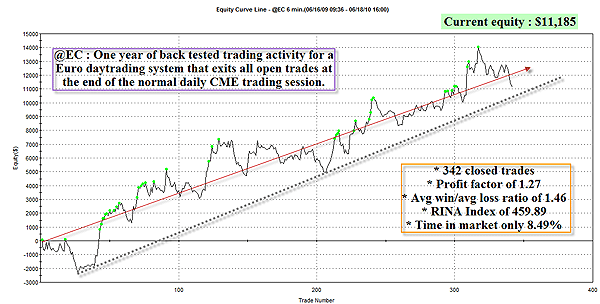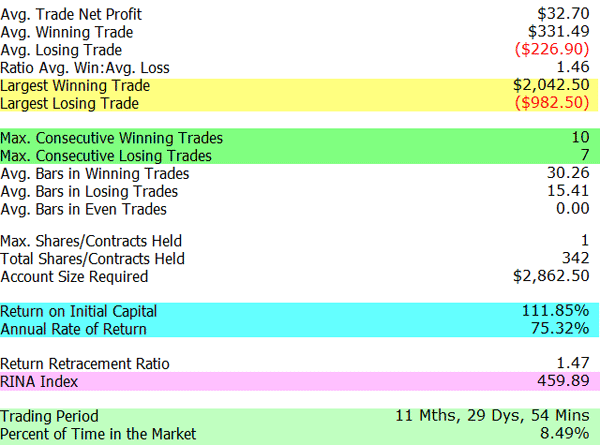
HOT TOPICS LIST
- MACD
- Fibonacci
- RSI
- Gann
- ADXR
- Stochastics
- Volume
- Triangles
- Futures
- Cycles
- Volatility
- ZIGZAG
- MESA
- Retracement
- Aroon
INDICATORS LIST
LIST OF TOPICS
PRINT THIS ARTICLE
by Donald W. Pendergast, Jr.
How much time does your trading system spend in the market? Ideally, you want to deploy systems that make the maximum amount of money in the least amount of time, thus limiting your amount of exposure to the market.
Position: N/A
Donald W. Pendergast, Jr.
Donald W. Pendergast is a financial markets consultant who offers specialized services to stock brokers and high net worth individuals who seek a better bottom line for their portfolios.
PRINT THIS ARTICLE
TRADING SYSTEMS
Trade System Metrics And Time In The Market
06/21/10 08:41:44 AMby Donald W. Pendergast, Jr.
How much time does your trading system spend in the market? Ideally, you want to deploy systems that make the maximum amount of money in the least amount of time, thus limiting your amount of exposure to the market.
Position: N/A
| Serious system traders already know what they want out of their mechanical trading strategies. They want: * A steadily rising equity curve with minimal drawdown * The ability to perform well in a variety of market conditions (accumulation, runup, distribution, rundown) * A healthy profit factor and average trade net profit * A favorable winning percentage, especially for countertrend systems. Those are all worthy qualities that every trading system should possess, but have you also factored in another key statistic, one that is frequently overlooked by even the best traders? |

|
| FIGURE 1: EC. Swing and/or position trading systems might sometimes produce a smoother equity curve than this one, but the stats still bear witness to the fact that even daytrading systems (that is, no overnight exposure in the market) can produce sufficiently consistent profits to keep committed traders in the hunt. |
| Graphic provided by: TradeStation. |
| |
| The Figure 1 equity curve is derived from a full year's worth (June 2009 to June 2010) of historical testing on the euro currency futures contract (trading at the Chicago Mercantile Exchange), using six-minute intraday bars. It's a system of my own design, one that took a significant amount of time, effort, and faith to realize. Overall, it's a very pleasing equity curve, one that regularly makes new highs without a lot of drawdown in between. But this positive expectation trading system is only in the market 8.49% of the time. Think about that for a moment and let a few of the implications sink in as to how this can benefit serious traders: 1. Since you're parked in cash a full 91.5% of the time waiting for the next trading signal, you'd have the opportunity to put at least a part of your funds (assuming your account is large enough to meet the margin requirements for trading a different futures market contract) to work in a completely different system, one that trades an entirely different market. 2. If the two markets are generally noncorrelated, you may be able to fine-tune the two systems to produce a smoother combined equity curve than would be attainable by either system on its own. 3. Of course, if you have a really big margin account, perhaps you could expand on this concept by trading four or five different markets (again, those that are generally noncorrelated) with four or five unique systems, thus producing an especially smooth and profit-enhancing equity curve line that has only minor drawdowns. |

|
| FIGURE 2: STATISTICS. Obviously, the low "percent of time in the market" figure is a big plus for this mechanical euro daytrading system, but could you really deal with having seven straight losing trades? When selecting a system to trade, always make sure you have at least two (and preferably three) times the amount of maximum closed trade drawdown figure in margin account equity. For this system that means at least $9,000 to start trading this particular market, double the current CME initial margin requirement of $4,050. |
| Graphic provided by: TradeStation. |
| |
| In Figure 2, witness some of the key statistics for this intraday mechanical euro system. With 342 closed backtested trades during the past year, the results are especially interesting. Forthwith: * Time in the market was a mere 8.49%; the system does not hold trades overnight, making it much easier to trade from a psychological perspective, compared to other systems that keep trades open at the end of the daily session. * The RINA index of the system is nearly 460; this simply means that it produces plenty of net profit in relation to the drawdowns that it experiences during the amount of time that it's actually holding open trades in the market. When you compare system stats, always focus on the system with the higher RINA index, all else being equal. One of those other, "all else" factors is the maximum number of consecutive losing trades, which for this system is relatively high at seven. The average losing trade came in at about $227, meaning that the average closed trade drawdown would be about $1,589. Clearly, you would not want to be trading this system on a minimum amount of intraday margin (even though the system exits all open trades by the end of the daily CME trading session), but if you had at least $10,000 to $15,000 available, the drawdowns might still be emotionally tolerable for a committed trader. Conversely, the system also had 10 consecutive winning trades (averaging more than $331 each) at one point, too, more than balancing out the high number of consecutive losers. The performance figures are calculated using a $10 per trade ($20 round-trip) commission and zero slippage, based on a starting margin account balance of $10,000. So is this system for you? Only you can decide, but at least you now know some of the key performance stats that you need to be aware of when shopping for a system that's likely to keep on grinding out a steadily rising, smooth equity curve in the months and years to come. |
Donald W. Pendergast is a financial markets consultant who offers specialized services to stock brokers and high net worth individuals who seek a better bottom line for their portfolios.
| Title: | Writer, market consultant |
| Company: | Linear Trading Systems LLC |
| Jacksonville, FL 32217 | |
| Phone # for sales: | 904-239-9564 |
| E-mail address: | lineartradingsys@gmail.com |
Traders' Resource Links | |
| Linear Trading Systems LLC has not added any product or service information to TRADERS' RESOURCE. | |
Click here for more information about our publications!
PRINT THIS ARTICLE

|

Request Information From Our Sponsors
- StockCharts.com, Inc.
- Candle Patterns
- Candlestick Charting Explained
- Intermarket Technical Analysis
- John Murphy on Chart Analysis
- John Murphy's Chart Pattern Recognition
- John Murphy's Market Message
- MurphyExplainsMarketAnalysis-Intermarket Analysis
- MurphyExplainsMarketAnalysis-Visual Analysis
- StockCharts.com
- Technical Analysis of the Financial Markets
- The Visual Investor
- VectorVest, Inc.
- Executive Premier Workshop
- One-Day Options Course
- OptionsPro
- Retirement Income Workshop
- Sure-Fire Trading Systems (VectorVest, Inc.)
- Trading as a Business Workshop
- VectorVest 7 EOD
- VectorVest 7 RealTime/IntraDay
- VectorVest AutoTester
- VectorVest Educational Services
- VectorVest OnLine
- VectorVest Options Analyzer
- VectorVest ProGraphics v6.0
- VectorVest ProTrader 7
- VectorVest RealTime Derby Tool
- VectorVest Simulator
- VectorVest Variator
- VectorVest Watchdog
